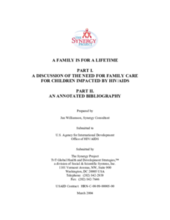In October 2002, representatives of 17 organizations convened in New York City at the invitation of the Firelight Foundation, and with the collaboration of the Bernard van Leer Foundation, the American Jewish World Service, and the United States Agency for International Development (USAID). Among the actions participants agreed on was the need to develop an overview of the guidance provided by the best available literature on how to provide for the care of children without family care. USAID subsequently agreed to assume this responsibility and arranged for the preparation of this annotated bibliography and overview paper.
The discussion paper found in the first part of this document is based on a review of approximately 80 documents related to the provision of care for children lacking family care in countries most affected by HIV/AIDS. Although the review is not exhaustive, it includes the most significant and relevant literature concerning this group of children. The materials reviewed have been annotated in the second part of this document. The annotated bibliography and the discussion evolved from a desire of several organizations concerned with children orphaned by HIV/AIDS to provide a firm conceptual basis for their work. This group of individuals, nongovernmental organizations (NGOs), governmental and religious organizations, and international organizations work against time and tremendous odds to develop care and protection interventions for the growing numbers of children made vulnerable by HIV/AIDS. From the literature concerning children without family care, the paper identifies:
-
The most common areas of concern,
-
The gaps of information most frequently mentioned, and
-
The solutions most frequently suggested for meeting the identified needs.
The documents reviewed focus primarily on the need for care addressed by a community-based approach. These documents also discourage the use of institutions as a form of care, and include suggestions for transitioning children out of institutionalized care and into community-based care. An important point of reference for these actions that emerged during the review is a paper prepared by the United Nations Children’s Fund (UNICEF), Joint United Nations Programme on HIV/AIDS (UNAIDS), and USAID, which outlines 12 principles to guide programming for orphans and other children affected by HIV/AIDS. The principles reflect the concerns by those working in the field to provide family care for children. Another significant source is Roofs and Roots, The Care of Separated Children in the Developing World, a book written by David Tolfree in 1995. Tolfree outlines the most comprehensive approach to date in examining care of children and the issue of institutions. In late 2003, a second book by David Tolfree was published, which is of equal and significant importance: Whose Children? Separated Children’s Protection and Participation in Emergencies. These three documents, along with three others—the USAID publications Finding a Way Forward and Children on the Brink (John Williamson), and the International Save the Children Alliance, A Last Resort: The Growing Concern about Children in Residential Care (Andrew Dunn, Elizabeth Jareg, and Douglas Webb)—should form the cornerstone for any library on the care of vulnerable children in need of family care.
©USAID

